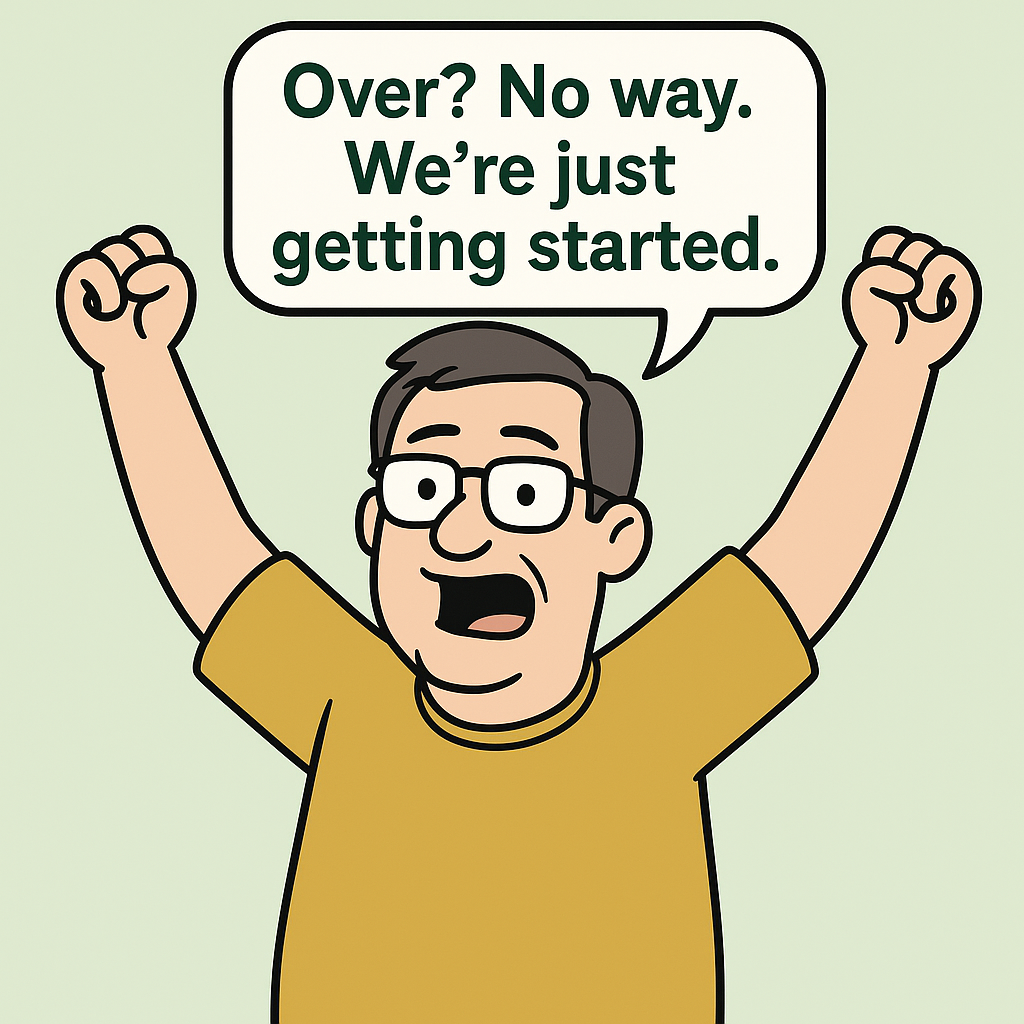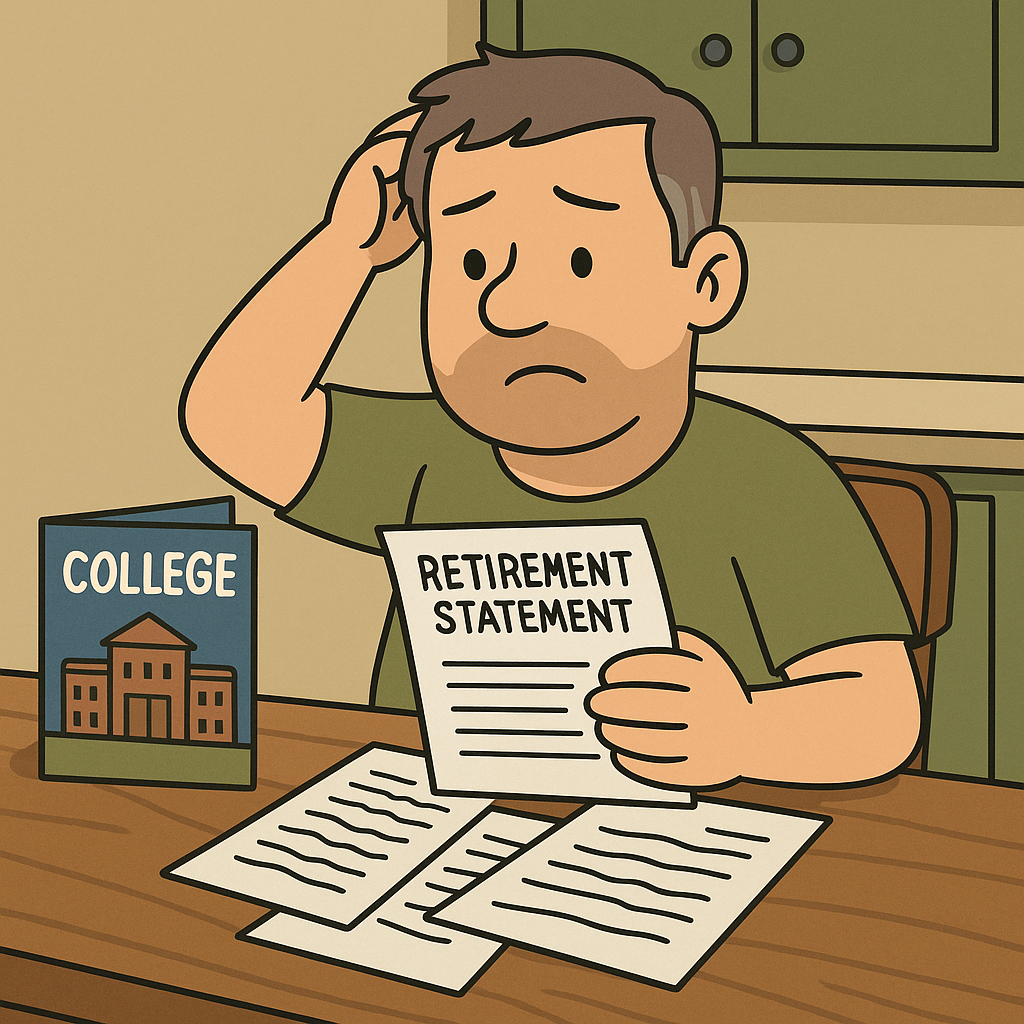How to Build Wealth When You Feel Behind
Is It Too Late? Hell No!
If you’ve ever typed “Is it too late to save for retirement at 50?” into Google at midnight with a pit in your stomach, you’re not alone.
I’ve been there. I’m not a financial advisor. I don’t wear a suit, manage hedge funds, or have three glowing computer monitors tracking the market. I’m just a regular dad in the middle of life — mortgage, family, kids, bills, and a retirement account that sometimes feels more “oops” than “on track.”
It’s easy to feel like you’ve blown it. Retirement savings ads show smiling couples walking on beaches at 55 while you’re sitting at the kitchen table wondering how to cover next semester’s tuition. But here’s the thing: it’s not too late.
You may not retire early with a yacht, but you can absolutely build stability and freedom if you start now. You’ve still got 10–20 prime earning years ahead of you. This guide is about using them wisely.
The Reality Check
Before we talk about hope, let’s be real about where most people stand:
- The median retirement savings for people ages 45-54 is around $115,000. That’s the median, not the millionaire fantasy.
- Many of us are juggling college costs, aging parents, mortgages, and debt at the same time.
- And let’s be honest: life happened. Careers stalled, medical bills showed up, kids needed things, we didn’t max out the 401(k) at 25 because we were barely paying rent.
But here’s what matters: you still have time. Compound growth works in your 50s. It’s not as turbo-charged as starting at 22, but it’s still powerful. And your income today is probably higher than it was back then, which gives you more leverage.
Think of it this way: even if you only invest for the next 15 years, that’s 180 months. Each one of those months is a chance to get ahead.
Step 1: Max Out Catch-Up Contributions
This is the easiest win — and the IRS actually helps you here. Once you turn 50, you’re allowed to put more money into retirement accounts.
- 401(k): $23,000 + $7,500 catch-up = $30,500 total (2025 numbers).
- IRA / Roth IRA: $7,000 + $1,000 catch-up = $8,000 total.
If both you and a spouse qualify, that’s potentially $76,000 a year into retirement accounts.
What if you can’t max out?
That’s okay. Even nudging contributions up 2–3% each year makes a difference. If you’re putting away 10%, aim for 12%. If you’re at 12%, push to 15%.
Example: If you invest an extra $500 a month for the next 15 years and earn 7% returns, that’s about $156,000 more at retirement. That’s one small decision compounding into real money.
Step 2: Treat Your HSA Like a Retirement Account
If you’re on a high-deductible health plan, you’ve got access to a secret weapon: the HSA (Health Savings Account). It’s the only account that’s triple tax-advantaged:
- Contributions go in tax-free.
- Investments grow tax-free.
- Withdrawals for medical expenses come out tax-free.
That’s like a unicorn in finance.
At 50+, healthcare costs are going to be a major part of your budget in retirement. Fidelity estimates the average 65-year-old couple will need $315,000 for medical expenses in retirement (not counting long-term care). Ouch.
Using your HSA as a long-term investment account, instead of just a “pay this year’s bills” account, gives you a pot of money dedicated to that future expense.
“If you’re feeling behind on retirement savings, you’re not alone. In fact, the median person in their 50s has less than $100K set aside. The good news? You can still make progress. One tool worth a closer look is the HSA — I even called it the best retirement account you’ve never used. Here’s why.
Step 3: Get Serious About Debt
Debt in your 20s and 30s can feel like background noise. Debt in your 50s feels like a weight on your chest.
The key now isn’t just saving but also freeing up cash flow.
- Credit cards: These are emergency-level. A 27% interest rate wipes out your investment returns. Attack these first.
- Car loans: If you’re financing cars into your 50s, consider downsizing. A paid-off, reliable car is freedom.
- Mortgage: This one’s nuanced. Paying it off early can reduce retirement expenses, but not at the cost of skipping retirement savings. Run the math.
Every debt you eliminate is money that can flow into retirement accounts instead of lenders’ pockets.
Tame Debt with a Budget You’ll Actually Stick To
Paying down debt is a lot easier when you know where your money’s actually going. That’s where budgeting apps can help. You don’t need to be an Excel wizard — these tools connect to your accounts, track your spending automatically, and keep you honest. I have personally used all three and loved aspects each. I was a Mint guy until it went away and now find myself with Rocket Money. YNAB might be the best tool, but I am always looking for the cheapest option (cause I’m cheap).
Some worth checking out:
- YNAB (You Need A Budget) — Great if you want a hands-on, “give every dollar a job” approach.
- Rocket Money — Good for tracking subscriptions and cutting out waste.
- Mint (RIP, but alternatives like Monarch Money) — If you liked Mint (I did), newer apps like Monarch Money pick up where it left off.
The point isn’t to find the “perfect” tool — it’s to stop letting money sneak out the door without you noticing.
Step 4: Rethink the House
Your home is usually your biggest financial lever. Ask yourself:
- Do I really need this much space once kids are out?
- Could downsizing cut my monthly costs by 30% or more?
- Would renting in retirement actually be simpler than owning?
Example: Selling a $600,000 home, paying off the mortgage, and moving into a $350,000 condo frees up equity and slashes property taxes and upkeep. That difference alone could add $1,000–$2,000/month in retirement breathing room.
Even if you’re not ready now, running these numbers gives you options.
Step 5: Keep Investing Simple
Here’s where a lot of midlifers go wrong — chasing complicated investments because they think they need to “make up for lost time.”
Don’t.
- Index funds are your friend: low-cost, broadly diversified, and built for long-term growth.
- Stick to a simple mix: U.S. stocks (S&P 500 or Total Market), international stocks, and some bonds.
- Automate contributions and ignore the noise.
Trying to beat the market at 50 is like training for the NFL at 40. Entertaining, maybe, but not realistic. Focus on steady, boring, proven growth.
Step 6: Delay Social Security (If You Can)
This might be the most underappreciated move. Every year you delay taking Social Security after 62, your benefit grows. By age 70, it’s 76% higher than at 62.
That’s like giving yourself a guaranteed raise for life.
Of course, life happens — health issues, layoffs, or financial needs might mean taking it earlier. But if you can afford to wait, you’re buying yourself a bigger, inflation-adjusted paycheck for the rest of your life.
Lifestyle Adjustments That Matter
Retirement planning isn’t just numbers; it’s lifestyle. And a few key moves now save a ton later.
Stay Healthy
The cheapest healthcare is staying out of the hospital. Exercise, sleep, and managing stress matter as much as saving. Each avoided prescription or procedure is money in your pocket.
Build Side Income
Side hustles aren’t just for 20-somethings. Consulting, freelancing, tutoring, coaching — these can supplement retirement savings and ease the transition if you want to work part-time later.
Smarter Spending
Forget the extreme “cut out everything fun” advice. Instead:
- Audit subscriptions.
- Buy quality once instead of cheap twice.
- Trim waste that doesn’t bring joy (looking at you, cable bill).
The Mindset Reset
This might be the hardest part. If you’re in your 40s or 50s and feel “behind,” shame and guilt show up fast.
But here’s the truth:
- You’re not alone.
- It’s not too late.
- Every step you take now compounds.
Think progress, not perfection. If you can make your financial situation just 1% better each month, that’s 12% better in a year.
You don’t need to be the richest person in the room. You just need to be the most prepared version of yourself.
Closing
It’s not too late. But you can’t wait either.
This site exists because I’m in the same boat. I’m figuring it out as I go, sharing what works and what doesn’t. No hype. No “get rich quick” scams. Just real money talk for real people in the middle.
If you’re curious about little-known strategies, there’s even a rare IRS rule that lets you move money from a retirement account into an HSA. It’s a once-in-a-lifetime play most people don’t know exists. I broke it down here.




Pingback: Should You Downsize Your Home After 50? - In The Middle Money
Pingback: No Retirement Match: What You Need to Know - In The Middle Money
Pingback: Which Retirement Buckets Should You Fill First? - In The Middle Money
Pingback: Should My Spouse and I Each Have Our Own Roth IRA? - In The Middle Money
Pingback: Should I Have a High Yield Savings Account? - In The Middle Money